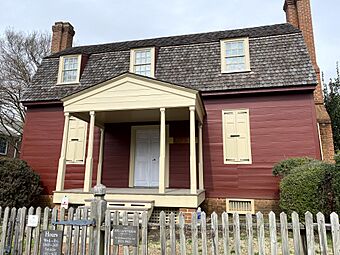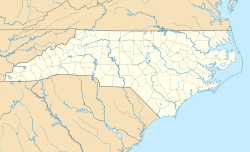Joel Lane House facts for kids
Quick facts for kids |
|
|
Joel Lane House
|
|
 |
|
| Location | 728 W. Hargett St., Raleigh, North Carolina |
|---|---|
| Area | 0.5 acres (0.20 ha) |
| Architectural style | Georgian |
| NRHP reference No. | 70000472 |
| Added to NRHP | July 28, 1970 |
The Joel Lane House, also called Wakefield, is a historic home and museum in Raleigh, North Carolina. It was built way back in 1769! This makes it the oldest house in Wake County. Inside, you can see collections of items and furniture from the 1700s. The museum also has another house from around 1790, a city garden, and an old-fashioned herb garden. The house is named after Joel Lane, who is known as the "Father of Raleigh" and the "Father of Wake County."
Contents
Who Was Joel Lane?
In the late 1760s, Joel Lane settled in an area called Wake Cross Roads. This was in what was then Johnston County, but it's now part of central Wake County. Joel Lane and his house were very important in North Carolina's journey from being a colony (ruled by another country) to becoming a state. They also played a big part in making Raleigh the state's capital city.
Joel Lane's large farm, or plantation, was on a small hill. From there, he could look out over the land where Raleigh would later be built. He owned thousands of acres of land, which gave him a lot of influence in politics.
Lane's Role in North Carolina's History
Creating Wake County
Joel Lane was a member of the colonial General Assembly, which was like the government's law-making group. He worked hard to create Wake County in 1770. At that time, it was mostly wild land with very few people living there. The county was named "Wake" to honor Margaret Wake, who was the wife of the colonial Governor, William Tryon.
Important Meetings at the House
In 1771, it's believed that Wake County's first court meeting happened at Joel Lane's home. Lane was chosen to be a member of this court and stayed in that role until he passed away. During the Revolutionary War, Wake Cross Roads was a place where important government meetings took place.
- In 1776, Lane hosted the colony's Council of Safety, a group that helped guide North Carolina during the war.
- The next year, he got a license to open a small inn at his home.
- From May to June 1781, the state's General Assembly even held a session at Lane's property.
Joel Lane also served in the state Senate for 11 out of 14 sessions between 1782 and 1794. He was also a delegate, or representative, at a meeting in Halifax in 1789. At this meeting, they approved the United States Constitution for North Carolina.
Raleigh Becomes the Capital
Joel Lane was directly involved in the decision to make Wake County the permanent capital of North Carolina. In 1792, the state government decided to buy 1,000 acres of his land. This land was used to create the city of "Raleigh" as the new center for the state government. The western edge of the new city was just east of Lane's house. A street in Raleigh was even named in his honor.
After Joel Lane died in 1795, his house had several different owners. In 1818, a businessman named William Boylan bought it. The house, along with another home called Montfort Hall, stayed in the Boylan family until 1909. As Raleigh grew, the city eventually surrounded the house. Lane's old farm land became the site of new streets, homes, and businesses.
In 1911, the house was moved a short distance from its original spot. Then, in 1927, a group called the National Society of Colonial Dames of America in the State of North Carolina bought the house. They wanted to make sure it would be saved and preserved. This organization still runs the Joel Lane House today as a museum, which is also a Raleigh Historic Landmark.
Recent Restoration Work
In 2019, the Joel Lane House celebrated its 250th anniversary! To mark this special occasion, a team worked to restore the house. They carefully removed 26 layers of old paint to fix the wood underneath that had been damaged over time. After the repairs, the house was repainted to look just like its original color: a beautiful garnet red.
Gallery
See also












